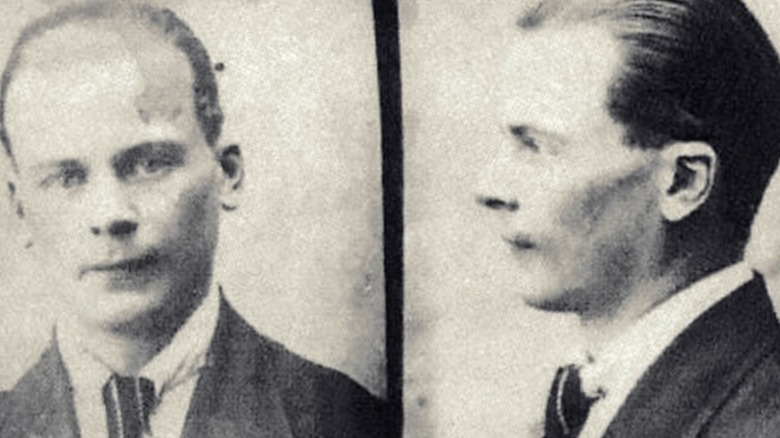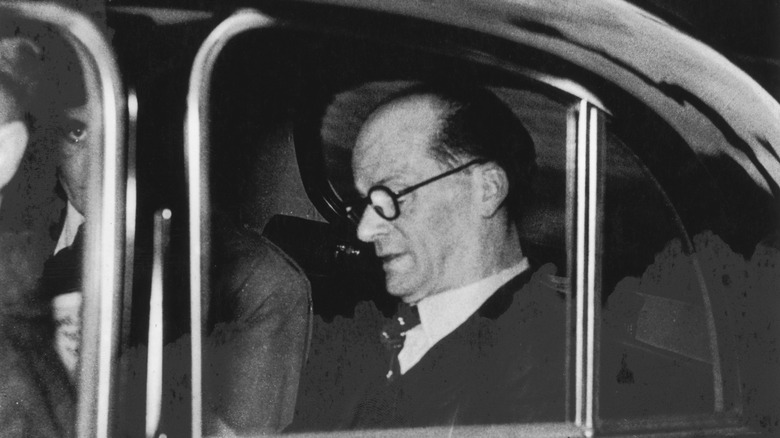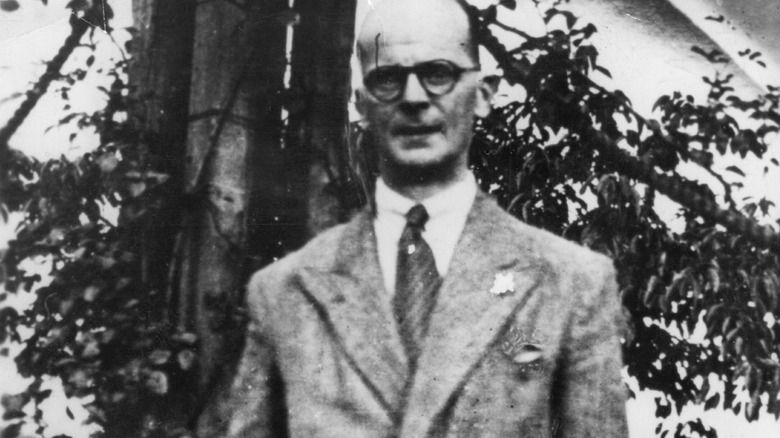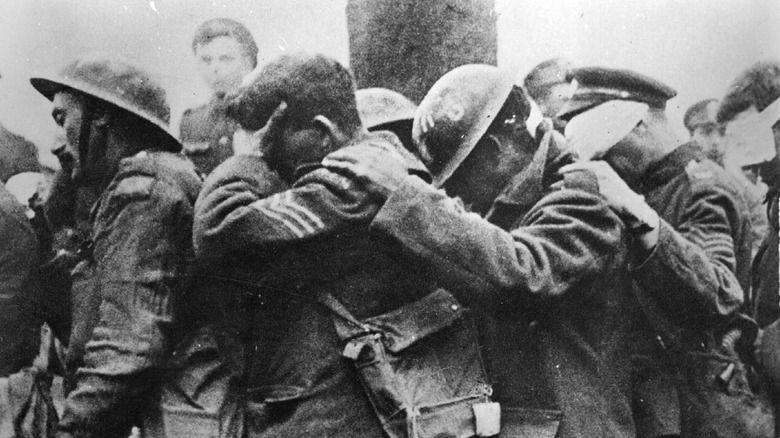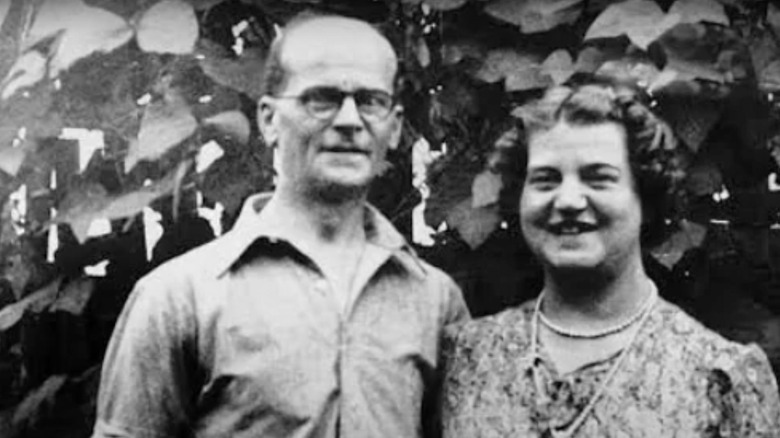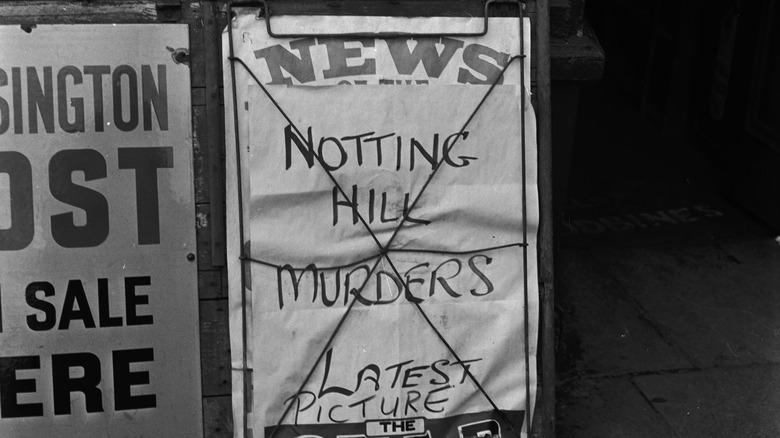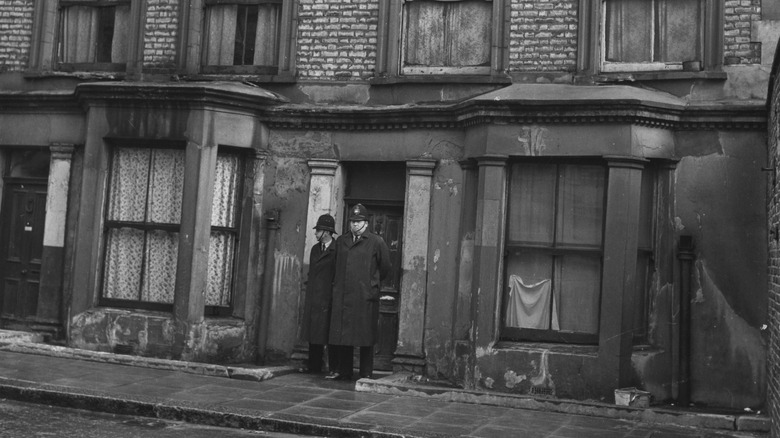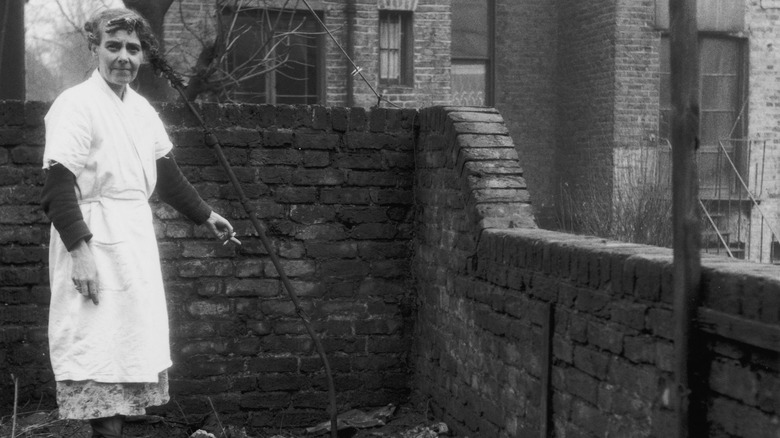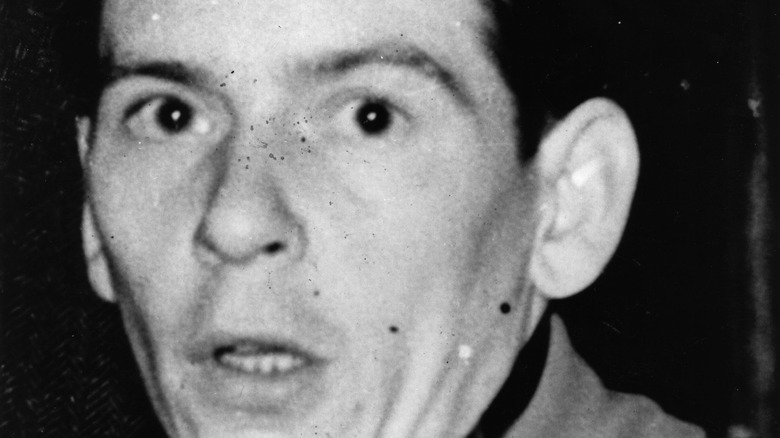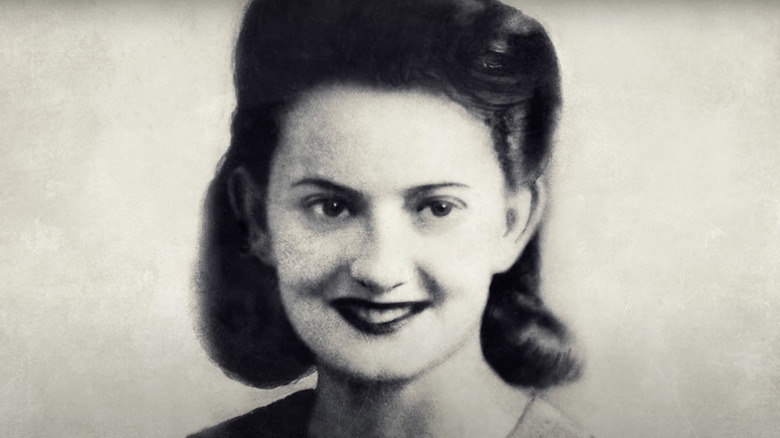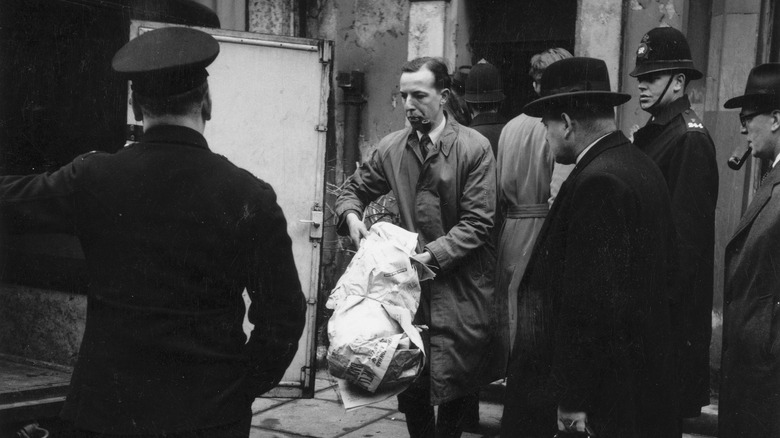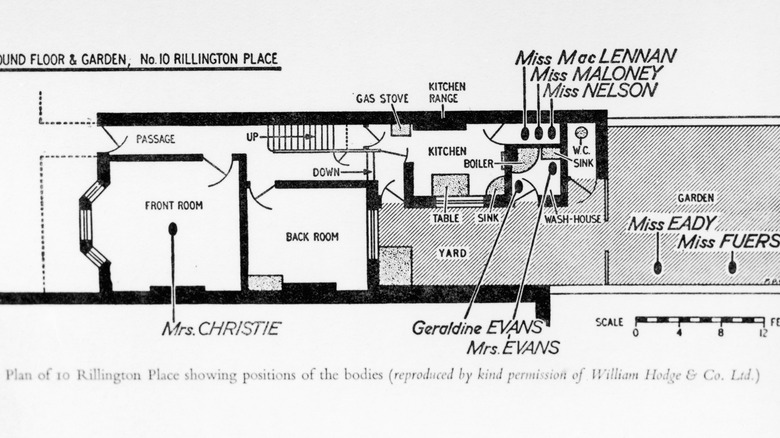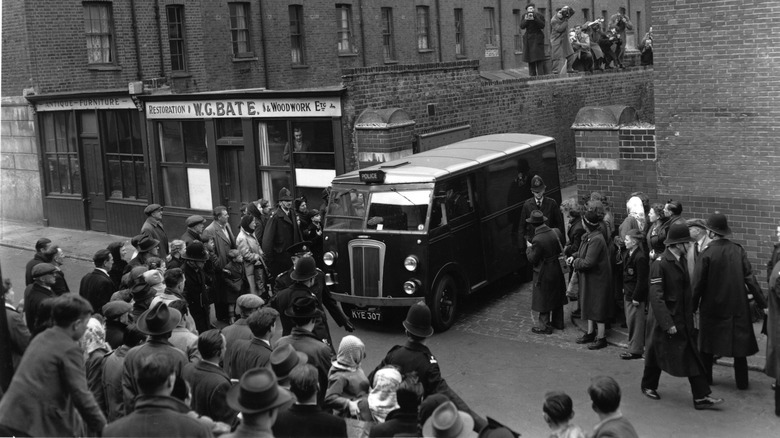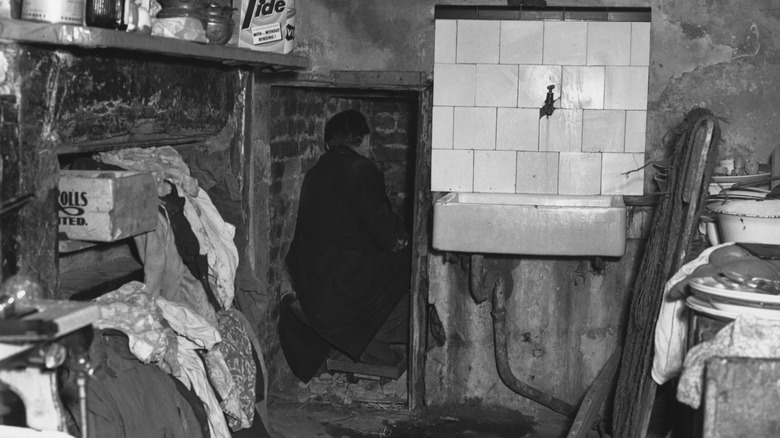The Messed Up Truth Of Serial Killer John Christie
Notting Hill, London, England, now is a highly gentrified part of West London which houses oligarchs and celebrities; however, in the '40s and '50s, it was the home to immigrants and flats with cheap rent, often leading to exploitation of the poor and the creation of slums. As one observer put it in The Independent, Notting Hill was "a massive slum, full of multi-occupied houses, crawling with rats and rubbish." The terraced houses look dilapidated by time in pictures, and 10 Rillington Place was no different. And, yet, because of what laid hidden within its property, it set itself apart to the point that when those houses were torn down and rebuilt in the '70s, they left a gap where 10 Rillington Place used to stand.
When the police arrived at the behest of another tenant in 1953, what they found was the stuff of nightmares. Bodies were hidden in a secret kitchen alcove, under the floorboards, and buried in the garden around the flat (via Radio Times). By this time, the police knew without a doubt who they were looking for. It was a man they had met three years prior who had been involved in another set of murders but ultimately cleared of charges. They would find this man — John Christie — homeless and giving the officer who stopped him a false name before he was arrested.
Early life
It seems that from what genealogical history of John Christie's family could be found, he grew up solidly middle class in Halifax, England. Christie loved his mother and called her, "a wonderful woman who lived for the happiness of others." She was the person all of the neighbors would come to when they had troubles. Christie was his mother's favorite. It seems that there was no want of love between Christie and his mother. His father, on the other hand, was a very prideful and strict man. Christie and all of his siblings were afraid of him. Christie said that he "always lived in dread of him" and that "Father [was] very strict but only beat me twice." It appears that Christie gained an affinity for gardening from his father.
There was one formative moment, according to Jonathan Oates, author of "John Christie of Rillington Place", for the young Christie, and that was when he saw the dead body of his grandfather, David Halliday. "All my life I never experienced fear or horror at the sight of a corpse. On the contrary I have seen many and they hold an interest and fascination over me." It seemed that corpses were people that could do no harm to Christie, and yet he had power over them. Oates goes on to show that this type of feeling about death was common in other killers, like Denis Nilsen.
Can't-Do-It-Christie
Along with his familial woes, John Christie became sexually frustrated from an early age. Jonathan Oates writes in "John Christie of Rillington Place" that Christie never considered himself notably handsome and was often insecure at the mere idea of sex since he never got any form of sex education from his parents. His schoolmates would go out to a "lover's lane" of sorts in Halifax and find members of the opposite sex who they would cuddle and kiss, at the very least. Yet Christie never found any girls on these "monkey runs." On the occasion when he finally found a girl, there was no sex involved, and the girl told his mates that he was slow. This, of course, led to insults like "No Dick Reggie" and "Can't-Do-It-Christie."
This impotence and doubts around sex would carry on throughout his life. This would lead to Christie's consistent spying on younger females and visiting sex workers before and during his marriage to Ethel Christie (nee Simpson), according to a Sheffield, England regional researcher and historian, Chris Hobbs. On top of that, Christie admitted during his murders that "the only way he could attain potency was with victims he rendered helpless" (via The Watford Observer).
Mustard gas caused John Christie to be blind and mute?
John Christie enlisted as a private in September 1916 in order to fight in World War 1, even though he was only 17 years old. Many reasons could be given for him enlisting and getting his papers for service before he turned 18. Jonathan Oates in "John Christie of Rillington Place" states that it could have been anything from escaping his dull and strict home, to some semblance of proving his manhood (considering his impotence), to "a wish to come in contact with death on a grand scale." During his time in the army, he was offered promotions three times, which according to Oates, would not have been impossible, considering the army at that time would often promote soldiers who were intelligent and educated.
Yet, It was a mustard gas shell blast that led to Christie stating that he was mute, blind, and suffered from hysteria for three and a half years after this incident. That said, Oates notes a report that said that "there is no evidence that Christie suffered or was treated for any eye complaint." Oates goes on to say that he only had a temporary loss of speech and that his whispery voice and sore throats were largely due to gas poisoning. There is little to no evidence that Christie's physical isolation from the world for three and half years actually took place.
An unhappy marriage
John Christie and Ethel Simpson were married on May 10, 1920; the marriage would be a difficult one, even though, as Chris Hobbs reports, Christie tended to paint the marriage in largely happy terms: "they had a few differences but they did not amount to much." However, they would only remain together for four years before they separated due to Christie's increasingly violent behavior. Ethel remained in Sheffield while he moved to London. Christie would be in and out of prison for the next decade while they were separated (via Express).
It was during this decade apart that Ethel had an "affair" with Vaughn Brindley while she worked as a shorthand typist for a steelworks company. This affair took place between 1928 and 1932, and she had told Brindley early on that she was married but that her husband died in a gas attack in the war. Brindley had accepted this as truth, but the affair did not last due to the revelation that Ethel could not have children. Brindley wanted children, and, even though she said she was in love with him, the relationship was ended.
Early minor crimes
While Ethel Christie was in Sheffield and having an affair with Vaughn Brindley, John Christie had moved to London and began a life of crime, including being convicted of theft, larceny, and assault (via Express). The Radio Times reports that some of his earliest crimes were petty, such as stealing a 12-year-old bike and raiding a cinema office. Yet his behavior would become more erratic and violent with his crimes. In 1928, he became flatmates with Mrs. Maud Claude and her young son, and this arrangement went south fairly quickly, to the point that Christie took a cricket bat to the back of Claude's head. He was found guilty of "grievous bodily harm" — he said he was only "testing" the bat — and was given six months of prison with hard labor.
His last bout with minor crimes came in 1933 when he stole the car of a priest, for which he got three months in prison. It would be during this stint in prison that he would reach out to his wife for the first time in a decade, and in 1934, Ethel Christie would find her way back to him in the wake of her affair, according to researcher Chris Hobbs.
Reunited and it feels so good
When John Christie was released from Wandsworth Prison in 1934, he and Ethel Christie reunited, moving into 10 Rillington Place in Notting Hill, London, in 1938. That's where John's violence would become fully ignited. As The Watford Observer reports, John's predilection for "sexual deviance" would be practiced within the flat while Ethel would be out of town visiting her mother. Yet, on the surface, John seemed to be on the straight and narrow. While living in a working-class part of London, he had gotten as job as foreman at Commodore Cinema in Hammersmith and eventually joined the War Reserve Police around the time of World War II. This took place because they didn't check his criminal history (via The Criminal Code).
It seemed that John was living two lives — a public one and a secret one — while Ethel lived with him. Yet the facade began to crumble as he continually visited sex workers and became more violent at home (via Express). He would also begin an affair of four years with a woman he met at a police station while on the War Reserve Police. The two lives were about to collide with tragic consequences.
The murders, part I
It wasn't until after John Christie's affair ended and he got beaten by the woman's husband (who had returned from war), that his serial murders would begin. His first known victim was Ruth Fuerst, an Austrian munitions worker (and also sex worker). As reported by Radio Times in their timeline of Christie's acts of murder, Christie said he strangled her to death during sex and then hid her body under the floorboards before moving her body to the garden. It was after this that he resigned from the police and started work at the radio factory where he would meet Muriel Amelia Eady.
Eady would be Christie's second victim, and he lured her in by saying he had a cure for her bronchitis. It turned out Christie's "cure" was carbon monoxide gas. This knocked her unconscious, and Christie began to strangle her and rape her unto death. He placed her body next to Fuerst's in the garden (via The Criminal Code).
The murders of Beryl and Geraldine Evans
A new couple, Timothy (pictured above) and Beryl Evans, would move into the flat above the Christies in 1948, and that would provide John Christie with his next victims. In October 1948, the Evans welcomed a new child into the world, Geraldine. It was noted in "John Christie of Rillington Place" that the Evans' marriage, while generally loving, was not free of arguments, some becoming quite loud to the point that Ethel and John could hear them. It would be a year later, in 1949, when Beryl and Geraldine would disappear.
Timothy reported the disappearance to the police, and their bodies were eventually found wrapped in blankets in an outdoor washroom. The body of Beryl showed signs of sexual assault. It would be Timothy who would bear the brunt of most accusations, including the sordid tales of their arguments told to the police by the Christies. He denied his involvement in their deaths the whole time. Yet he was charged with their murders due, in part, to John Christie's testimony. He was hanged to death in 1950 (via The Criminal Code).
Botched abortion?
While it is largely agreed upon that John Christie killed both Beryl (pictured above) and Geraldine Evans in 1949, there's a side of Timothy Evans' story that's not always told. It seems that, a month prior to their murders, Beryl had relayed to Timothy that she was pregnant again. She did not want the baby because of the cramped conditions and their financial instablility due to Timothy's inability to keep a job — supposedly because he had an IQ of 70 — and her inability to not keep spending (via NY Daily News).
An article published in The Historical Journal deals with the rhetorical place of abortion as a female criminal act and the male abortionist as an exploiter with sexually tinged ulterior motives in mind. The article notates Timothy's three confessions: two of those involved abortion — one self-induced and one with Christie as the abortionist — and one involved domestic violence and murder. The article tracks the ways in which "abortion" played a part in the Christie murders and the means by which he drew women in. In the '60s, when abortion reform became en vogue, the idea of Christie posing as a back alley abortion doctor to lure victims to his house seemed more fitting, but in the early '50s, such lines of inquiry were taboo and hidden. This speaks to the inconsistency of abortion being talked about in the case (even to this day) and how taboos can lead to shoddy investigations.
Incompetent police work
On top of confusion around John Christie's part in the death of Beryl and Geraldine Evans, the police's investigation into their deaths was incomplete and not at all thorough (via BBC). If it had been done properly, they might have been able to catch Christie before the death of his wife and the remaining women he killed. For instance, in 1946, Christie dug up a femur bone — which probably came from the body of Ruth Fuerst — and yet he didn't try to hide it. In fact, he used it to prop up a trellis. This huge bone would have been there as the police were searching the property for Beryl and Geraldine, according to The Independent.
It is also clear that Timothy Evans' changing confessions showcase a level of coercion that led to Evans' execution. This is not to mention the police taking the story the Christies told them at face value without any attempt at digging deeper to find any inconsistencies (via Huffington Post).
The murders, part II
John Christie getting away scot-free after the Evans fiasco freed him up to murder again. In December 1952, according to researcher Chris Hobbs, Christie murdered his wife in their bed by strangling her with a stocking. He did this, it seems, because she had stopped visiting her mother in Sheffield after the murder of Beryl and Geraldine. The reason she stopped visiting? For one, her health was deteriorating, but there is some thought that she might have stopped in order to keep an eye on Christie's activities. This lack of privacy presented a problem for Christie if he were to continue his murder spree.
So, in response, he killed her.
Between January 1953 and March 1953, without the issue of his wife's presence, he killed his final three victims: Rita Nelson, Kathleen Maloney, and Hectorina MacLennan. All of these murders show the same causes of death: gas and strangulation. Nelson appeared to have been a woman pregnant and seeking help with an abortion, as might have been the case with Beryl Evans. It appeared that they were all sexually assaulted while they were passed out, according to Radio Times. All three of the bodies were hidden in the kitchen alcove.
The arrest
According to Radio Times, what led to the eventual arrest of John Christie was the discovery by his landlord that he illegally sub-letted his flat to another couple and had moved out. The landlord came and kicked the couple out of the flat, but Christie was nowhere to be found. The landlord allowed one of the tenants above the Christie flat, Beresford Brown – who was an Jamaican immigrant despised by the Christies – to use the sink in the flat. While attempting to put up a shelf, Brown noticed a secret alcove and discovered the bodies of Christie's final three victims. He contacted the police, and they uncovered all of the bodies in the house and in the garden (via NY Daily News).
As reported by The Watford Observer, Christie had been sleeping "rough" (or homeless) and was found on the Embankment at Putney. He attempted to give false identification, but it was to no avail because the officer who found him recognized him from the descriptions given. He would eventually admit to killing all of the women, except for little Geraldine Evans, and go to trial for the murder of his own wife, Ethel Christie.
He hung his head
The trial of John Christie in the murder of his wife began on June 22, 1953, when he placed a plea of insanity to the court; however, this defense was rejected by the jury, and he was found guilty of murder and sentenced to hanging on July 15, 1953 (via NY Daily News). His executioner was the same as that of Timothy Evans — a weird sense of poetic justice. The Radio Times reported the alleged last exchange made between Christie and his executioner: Christie spoke of an itchy nose when at the gallows, and his executioner responded with, "It won't bother you for long." He was then hanged.
Timothy Evans, in the wake of Christie's trial and death, was given a royal pardon in 1996, and his death played a part in Britain's decision to end the death penalty in 1965. To this day, some residents who live in the flats on top of where Christie's crimes were committed complain of weird goings-on, whereas others notice nothing. Once such inhabitant spoke about when they bought their property on the site: "I didn't have any bad vibes when I walked into the house ... And I thought to myself: London is a big city. Unless you can show me one plot of land where someone hasn't been killed slaughtered, raped or stabbed in the past 1,000 years –- well, I don't think that plot of land in London exists" (via The Independent).
